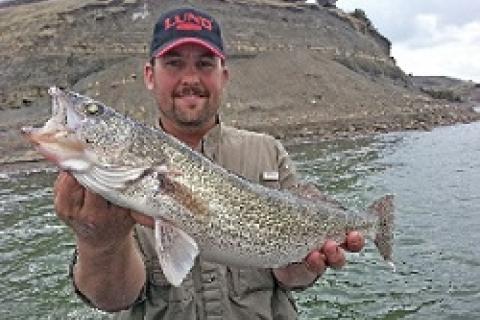
Want to have some fun? Try targeting big walleyes in shallow water. Anglers who claim walleyes don't fight as hard as other species have probably never hooked a 4- or 5-pound walleye in 3 feet of water. There are times and conditions when targeting the shallows produces bigger walleyes than rigging or trolling deep water.
One instance is in weedy lakes. Vegetation produces plankton, which attracts minnows, which bring in big walleyes and lots of them. Weeds act like a natural wall or edge. Walleyes will patrol the edges. When they find minnows, they'll herd them to shallow water closer to the weeds and cane to attack. The result is that whenever walleyes inhabit the greenery, they're there for just one reason - to feed. The action can be wild.
Use spinning gear. A 6-foot, 8-inch St. Croix LXS68MXF rod with 8-pound TUF Line XP will work great. The super thin diameter of a super braid will cut through a lot of weeds. Stick with a 1/8-ounce jig tipped with a leech or half nightcrawler. Use a slightly bigger jig when the wind is blowing.

Jig color? Shallow fish are often so hungry they won't seem to care.Try yellow glow to start.
The most productive weeds are often adjacent to deeper water. The best weed beds are the ones that stand alone isolated from all others.
Carp rolling in the shallows is also a good sign. They stir up the bottom and dirty the water. Walleyes can take advantage of their keen eyesight to gorge on baitfish.
Focus on the points and turns on the deep side first. Stay back from the edge and make short flips to the targets. Most casts should be under 15 feet. Twenty feet is a long one.
If you snag up, simply pull it free or pop it. Strikes will often come as the bait pops loose. Bring the jig back with a fast lift, reel, lift, reel motion. Try to guide your jig through the alleys where there are sparse weeds. Shallow fish are not bashful.
Try moving closer to pitch into the pockets of the green stuff. Weeds are best on calm days. But, a second shallow pattern relies on the wind.
Sustained, strong breezes will blow plankton to the windy side of a lake. That rings the dinner bell for minnows - and minnows attract walleyes into shallow water. Wind also stirs the bottom so walleyes can use their sight to good advantage.
At this time, target windy points and the windy side of islands. Try pitching a 1/8-ounce jig tipped with a minnow, leech or piece of nightcrawler. Or, choose a shallow-running crankbait that will dive deep enough to tick across the rocks as you retrieve.
Use your electric trolling motor to move along the shoreline just within a decent cast to the rocks. Anchor and cast if the wind blows too hard to control your boat. Retie often to avoid a nick to the line that could cost you a trophy fish.
You're not limited to casting lures or jigs in shallow water. In fact, there are some lakes where trolling is the best way to locate shallow fish fast. Trolling with the gas-powered Mercury 9.9 Pro-kicker can also give you boat control you may lack with other methods in the wind.
An excellent way to control your boat when it's windy and you are going to troll, is to use your gas kicker in conjunction with a MinnKota Terrova bow-mounted trolling motor. With the I-pilot Link you can control the boat remotely or use the Link feature to stay on the LakeMaster contour lines. Your boat will be much more responsive when you're controlling it from the front and the rear.
Use TUF Line Micro Lead or XP on 12-foot and 5-foot St. Croix Eye Con trolling rods. Use line-counter reels to precisely control lure depth. The more line out, the deeper they will go.
Get out the lake map and identify stretches of shoreline or islands on the windy side of the lake with as many different features as possible, such as points and turns. Areas with slow sloping shoreline and subtle changes in bottom composition are best.
Depending on state law, mount as many rods as you are allowed on the shallow side of the boat. Use good rod holders, like Tempress' Fish On, and try to get your lures as close as possible to the shoreline. Use at least one line to target the "mud line" where water clarity changes from murky to clear. Follow the contour of the shoreline while watching your depth finder to stay a safe distance from the rocks. Don't stay in deep water all the time. Shallow water rocks!
Contributed by Ted Takasaki and Scott Richardson
- 2439 views

